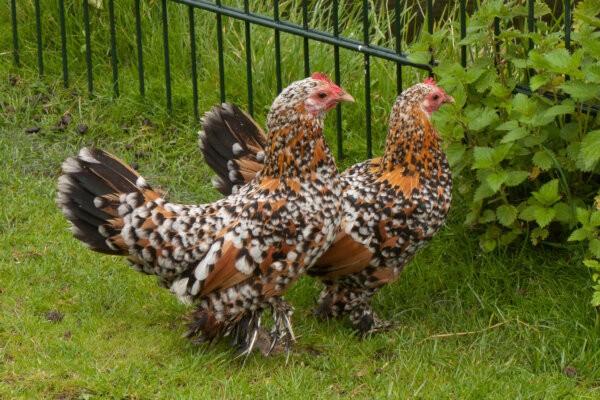
- Purpose: Pet/Show Bird
- Eggs: White
- Egg Size: Extra Small
- Color: Black, White, Brown, And More
- Comb Type: Single
Do you enjoy the cute looks of the Belgian Barbu d’Uccle, but you’d prefer them taller and clean shaven? Enter the Booted Bantam, a breed older than, yet easily confused with the bearded Barbu d’Uccle.
These tiny chickens, also sometimes called the Dutch Booted Bantam or Sablepoot, share many of the remarkable traits of their closely-related Duccle cousins, but have enough notable differences to be distinguishable as their own breed.
With little resistance to Marek’s Disease, it is worthwhile to look for birds bred with healthy, hearty bloodlines. You may need to do a little digging and calling around to find a reputable hatchery with this somewhat hard-to-find bird.
If you do come to acquire these dazzling, tiny chickens, you’ll also have to make sure they have adequate housing for all types of weather.
These chickens are not known for their hardiness and are particularly sensitive to cold. Additionally, if you allow your bantams to free-range, be aware that their large wing to tiny body ratio means they are capable flyers.
Description
A quiet, calm, and easily-handled bird, these chickens were made to be held and shown off. Their delicate good looks, wide range of potential colors and dedicated breeder clubs have made this the supermodel of the chicken world. If you are interested in exhibiting bantams, there is a huge community associated with this lovely little breed.
Booted Bantams would be a delightful sight cavorting through a backyard, and may even be less destructive to the ground or garden due to their long hock feathers. Keepers claim that their small size and pleasant, docile personalities make them an ideal chicken for supervised children to raise and keep. Many Booted Bantam breeders choose to house their diminutive flock on soft bedding or indoors to protect the distinctive, 6 inch-long hock feathers.
What’s the Yield?
These birds are used exclusively for exhibition or as pets. These truly tiny chickens reach a maximum potential weight of 30 ounces for roosters and 27 ounces for hens, so there is really no point in trying to use these as a table bird. With adorable personalities, looks, and potentially decade-long lifespan, why would you want to?
With two tinted or white eggs a week, they lay a fairly respectable amount for a bantam, but their tiny eggs would probably be more of a delicacy than a meal. With a tendency to go broody, you may find them to be far better mothers than omelet-contributors!
Watch Out For A Potential Mix-Up!
This breed is a little harder to come by than the similar Belgian Barbu D’Uccle, but the variety of colors you can find them in is truly dazzling. At least twenty different colorations are available, with many other “non-recognized” colors also possible.
Most popular are the complex Mille-Fleur patterning, but be sure you’re getting true Booted Bantams if you go by that plumage. Barbu d’Uccles are also sometimes known as Mille Fleurs and there is plenty of opportunity for a potential mix-up!
Pictures Of Booted Bantams
Resources
- Booted Bantam, Feathersite
- Booted Bantams, Poultry Keeper
- Belgian d’Uccle & Booted Bantam Club, Belgian d’Uccle & Booted Bantam Club
- Booted Bantam, My Pet Chicken
- Booted Bantam, Omlet
- Booted, Backyard Chickens
- Booted Bantam Society UK, Booted Bantam Society UK
- Booted Bantam Chickens, Chicken Coop Guides
- Booted Bantam, Raising Chickens
- Booted Bantam Chicken Breed, Backroads Living
- Booted Bantams, The Poultry Guide
- Booted Bantam, Everything Poultry







































